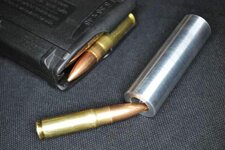No kidding. I was thinking about this the other day. It isn't possible is it? The round wouldn't fit into the chamber/barrel.
It can fit, especially with the lighter bullets. The shorter 125/110 grainers can be loaded short enough that they will sit inside the 556 chamber. As others have mentioned if you have any bullet setback the chances increase.
Anyone chambering/loading an AR (especially if you have both calibers on hand) needs to exercise reasonable intelligence/caution.












